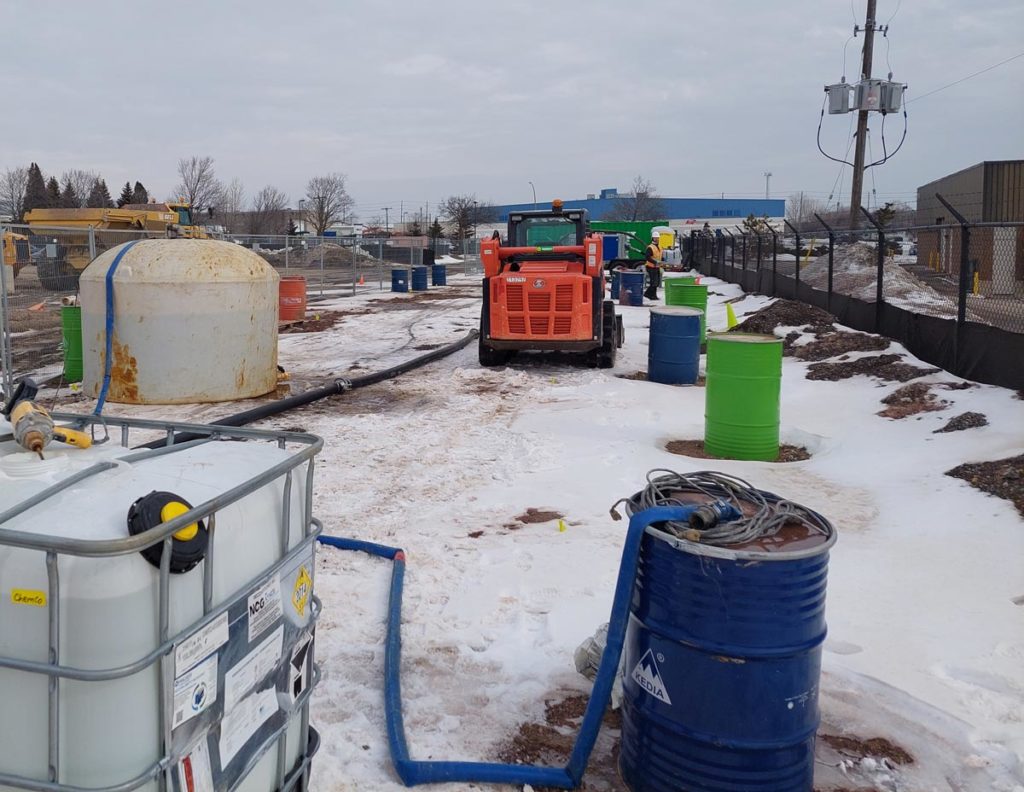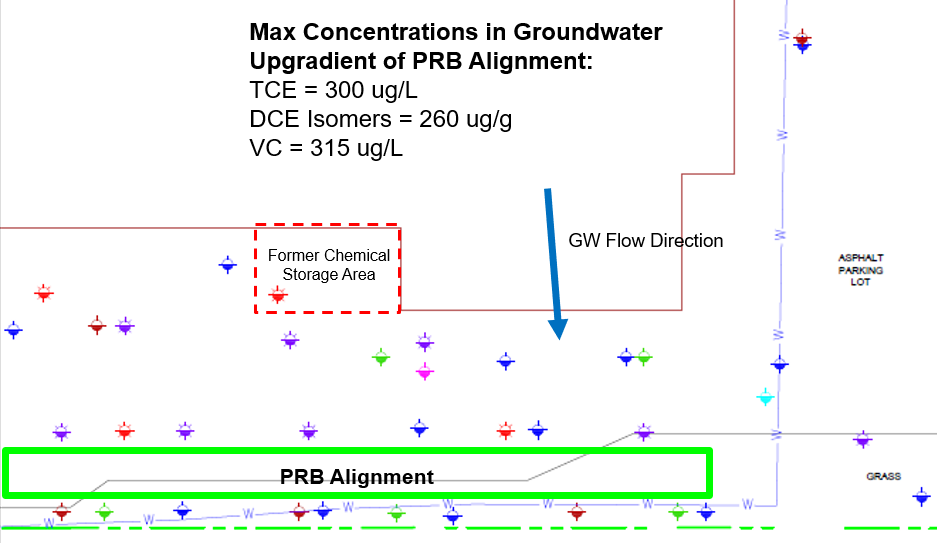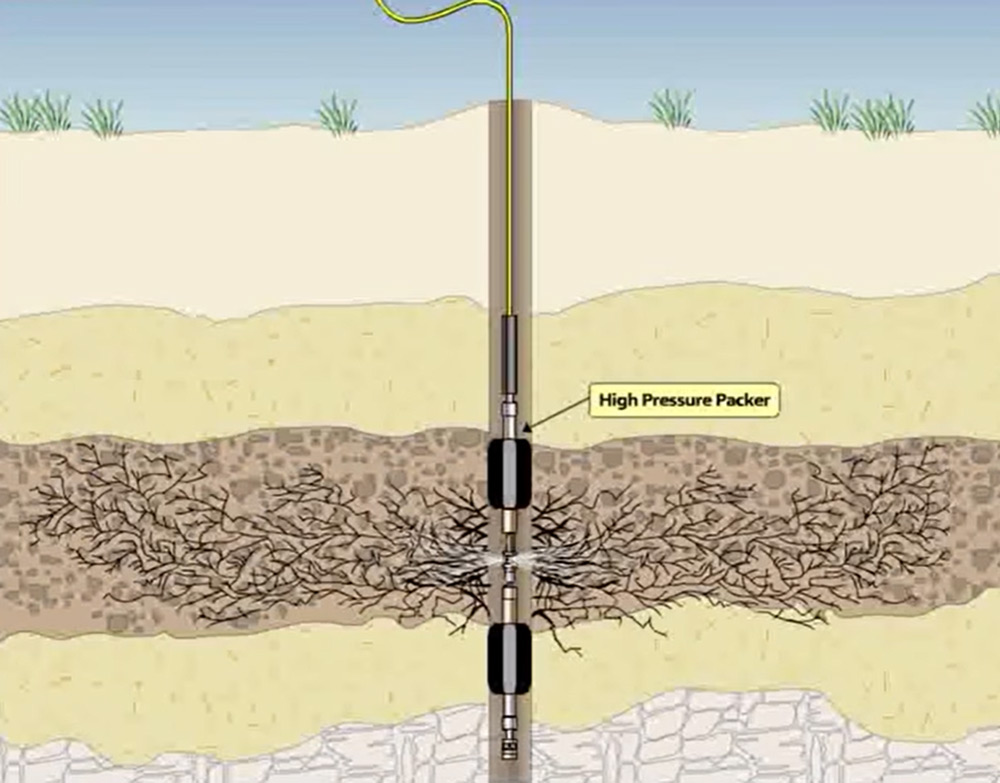
Overview
The site was formerly operated as a steel manufacturing facility that included historic degreasing operations and chemical storage. Environmental investigations identified the presence of chlorinated solvents, including trichloroethylene (TCE), dichloroethylene (DCE) isomers, and vinyl chloride (VC), in groundwater located in the shale bedrock underlying the site. A permeable reactive barrier (PRB) was needed to prevent the potential migration of the chlorinated solvent impacts to off-site areas. Recognizing that there can be issues relating to the use of non-persistent remedial amendments (such as aqueous solutions) and the effects of back-diffusion of contaminants out of the bedrock and into the groundwater present in the fractures, an effective and long-last in-situ remedial approach was required. The PRB ultimately designed and installed at the site by Vertex used the highly effective and persistent remedial amendment Trap & Treat® BOS 100®.

Site Layout and Contaminant Scenario
The Vertex Approach
First a series of injection boreholes (IBHs) were drilled along the designed PRB alignment using a drill rig equipped with air hammer tooling. Casing were set in place into the top of the bedrock to seal off the overburden material and open boreholes were then drilled down into the bedrock to the target depth of the base of the PRB. IBHs allow for the placement of a specialized pressure-packer assembly into the borehole annulus through which the injections of remedial amendments are complete. This is usually the first method undertaken at bedrock injection sites as it is the simplest and most cost-effective approach. However, in the event that this approach does not work, as was the case at this site, there is another way to complete the injections (described below).

Typical Pressure Packer Injection Assembly
How A Pressure Packer Works: Pressure-packers consist of upper and lower bladders (as shown in the adjacent graphic) that can be inflated to seal off a particular injection interval along the vertical profile of an IBH. Injections are completed by way of injection ports located in the central portion of the packer assembly (i.e., between the upper and lower inflated bladders). Once a specific injection interval is completed, the bladders are deflated, and the pressure-packer is moved to the next vertical interval. This process is repeated along the entire length of the IBH targeted for injections
As it turned out, injections via pressure-packers were not a suitable strategy to use at this site due to the highly weathered and friable condition of the shale bedrock. The IBHs exhibited frequent cave-ins during initial injection attempts, making it very difficult to efficiently move the packers within the IBHs (i.e., packers getting stuck/trapped by cave-in material). Therefore, the remedial injection program switched to the alternative GeoTAPSM approach in order to complete the full-scale PRB installation at the site.
The GeoTAPSM process involved retrofitting the IBH infrastructure previously installed at the site. To complete this, the cave-in material was first “cleared out” of each IBH using a variety of methods, including:
- “Extracting” material out with a hydrovac
- “Sampling” material out with direct-push macro cores
- “Flushing” material out with air hammer tooling
Once each IBH was “cleared out,” they were backfilled with hydrated bentonite to provide a sealed pathway for the subsequent advancement of the direct-push injection tooling that was then used to complete the injection of the remedial amendment into the bedrock. (Read more about the GeoTAPSM injection approach here.)
Outcome
At the end of the day, the conversion of the open IBHs into GeoTAPSM injection points allowed the successful direct-push injection of the targeted volume of 90,000 L of Trap & Treat® BOS 100® suspension across the entire targeted length and vertical interval of the PRB in the bedrock formation at the site.
This case study clearly demonstrates that successful remedial injections can be completed into bedrock, even if the bedrock itself does not always want to cooperate. Injections into competent bedrock can routinely be completed using injection wells and/or pressure-packers. But when the bedrock is overly fractured and friable there is still a way to effectively complete remedial injections using the GeoTAPSM injection approach.

